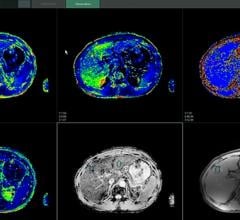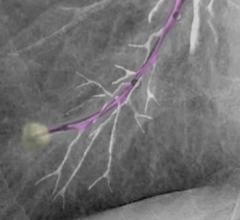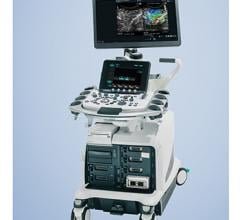
June 4, 2014 — Olympus announced the commercial availability of its U.S. Food and Drug Administration (FDA) 510(k)-cleared, next-generation BF-P190 and BF-XP190 bronchoscopes for peripheral and small anatomy bronchoscopy.
In 2012, there were approximately 871,000 bronchoscopies performed in the United States, based on Truven Health data, and bronchoscopy plays a key role in detecting and treating lung cancers. According to the American Cancer Society, lung cancer is the leading cause of all cancer-related deaths in the United States and will claim 159,260 lives in 2014, more than colon, breast and prostate cancers combined.
BF-P190 Extends Reach for Peripheral Bronchoscopy
With new recommendations from the U.S. Preventive Services Task Force calling for more proactive lung cancer screening of long-term smokers, the need for reliable methods of assessing peripheral lung nodules is forecasted to increase.
Transthoracic needle aspiration (TTNA) has long been the gold standard for sampling peripheral pulmonary nodules, but it can present a significant possibility of complications from pneumothorax. In a study by Geraghty et al, 27 percent (226 out of 846) of computed tomography (CT)-guided TTNA biopsy procedures were complicated by pneumothorax. Peripheral bronchoscopy using radial endobronchial ultrasound (EBUS) provides a minimally invasive alternative for sampling peripheral pulmonary nodules suspected of malignancy, with little risk of collapsing the lung. Used solely or in tandem with other modalities, radial EBUS is a proven approach for diagnosing lung cancer and other diseases in the peripheral areas of the lung, and can performed on an outpatient basis under conscious sedation.
The fully rotatable, slim design of the BF-P190 bronchoscope, along with its improved tip angulation, advances maneuverability to provide better access in peripheral airways. The bronchoscope also delivers the industry's largest working channel (2.0 mm) available in a slim 4.2 mm true videoscope, making it ideal for accommodating a variety of endoscopic devices.
"We're pleased to add the BF-P190 to our practice. The smaller outer diameter of the BF-P190 bronchoscope allows us to go further into the lung periphery, providing better access and visualization of third and fourth generation bronchi. This caliber bronchoscope consistently allows us to reach the mid lung and, in many cases, allows us to be within centimeters of peripheral lung lesions," said Alex Chen, director of interventional pulmonology, assistant professor of medicine and surgery, Divisions of Pulmonary and Critical Care Medicine and Cardiothoracic Surgery, Washington University in St. Louis. "The scope's rotation capabilities also allow for more comfortable hand positions during procedures, reducing hand fatigue and potentially improving procedural ergonomics."
In addition to the BF-P190 bronchoscope, Olympus offers a comprehensive peripheral bronchoscopy solution, including the radial endobronchial ultrasound (EBUS) probes (unique to Olympus), ultrasound processors, Guide Sheath Kit, TBNA needles, biopsy forceps and cytology brushes for extended reach beyond the tip of the scope.
BF-XP190 Advances Visualization in Small Anatomy Bronchoscopy
Flexible bronchoscopy is widely used in the diagnosis of respiratory pathologies in people of all ages. Biopsies, bronchoscopic cytology and foreign body removal present common challenges that are often addressed using bronchoscopy.
The BF-XP190 provides a new evolution of better imaging in an ultra-slim bronchoscope. A revolutionary mini CCD provides unsurpassed image quality compared to other ultra-slim bronchoscopes, and close-up observation of bronchial surfaces can be easily accessed with 1.2x and 1.5x electronic magnification.
With an outside diameter of 3.1 mm — nearly 1 mm smaller than its nearest competitor — and a 1.2 mm working channel, the BF-XP190 is the industry's slimmest true videoscope, making it the scope of choice for peripheral bronchoscopy.
BF-190 Bronchoscopes Powered by EVIS EXERA III Universal Platform
The BF-P190 and BF-XP190 bronchoscopes are designed to advance maneuverability, visualization and versatility. Key features include:
- Rotary Function: Insertion tube rotation of up to 120 degrees left and right effectively reduces hand torque by 82 percent, expands access in the periphery of the lungs, and supports easier insertion and positioning of endoscopic devices.
- 210 degrees Tip Angulation: The wide angulation range can be maintained even when an endoscopic device is inserted, making it easier to access difficult-to-reach peripheral areas of the lungs.
- SDTV Imaging: SDTV offers the highest quality imaging available in scopes of similar size. These scopes, in tandem with the EVIS EXERA III platform, offer the first true video system on the market for peripheral and small anatomy bronchoscopy.
- EVIS EXERA III Universal Platform: This powerful imaging system helps facilitate more accurate diagnosis and treatment and also simplifies set up and reprocessing. The system works seamlessly across specialties to provide easier data management and cost efficiencies.
The BF-P190 and BF-XP190 bronchoscopes will be showcased at the American Thoracic Society (ATS) 2014 International Conference to be held on May 16-21 in San Diego. Physicians are invited to visit Booth #4907 to further explore the benefits of these newest additions to the BF-190 bronchoscope series.
For more information: www.medical.olympusamerica.com


 December 23, 2019
December 23, 2019 








